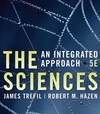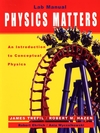Workshop Physics is one component of the Activity Based Physics Suite. It is a calculus-based introductory physics curriculum designed to completely replace traditional lectures and laboratories. In a typical two-hour Workshop Physics class session, students use equipment and computer tools for data acquisition, visualization, analysis, and mathematical modeling.
Link List
Labels
Blog Archive
-
▼
2006
(36)
-
▼
September
(36)
- Workshop Physics
- Activity Based Physics
- Six Ideas That Shaped Physics: Unit C: Conservatio...
- Six Ideas that Shape Physics - Moore , 2E
- The Sciences: An Integrated Approach - Trefil, 5E
- Physics Matters: An Introduction to Conceptual Phy...
- Physics Matters: An Introduction to Conceptual Phy...
- Physics Matters: An Introduction to Conceptual Phy...
- Teaching Introductory Physics, Homework & Test Que...
- Teaching Introductory Physics - Arons
- How Things Work: The Physics of Everyday Life - Bl...
- Interactive Lecture Demonstrations - Sokoloff
- Matter & Interactions II: Electric & Magnetic Inte...
- Matter & Interactions I: Modern Mechanics, Version...
- Understanding Physics, Student Solutions Manual
- Understanding Physics, 1E, Video CD for Students
- Understanding Physics, 1E, Study Guide
- Understanding Physics - Cummings, Laws, Redish, Co...
- Teaching Physics - Redish
- Activity Based Physics Tutorials, Volume 2 - Redish
- Activity Based Physics Tutorials, Volume 1 - Wittman
- Workshop Physics Activity Guide, Module 4 - Laws, 2E
- Workshop Physics Activity Guide, Module 3 - Laws, 2E
- Workshop Physics Activity Guide, Module 2 - Laws, 2E
- Workshop Physics Activity Guide, Core Volume + Mod...
- The Feynman Lectures on Physics, Definitive/Extend...
- Introduction to Computer Simulation Methods: Appli...
- Interactive Physics Player Workbook - Schwarz, 2E
- College Physics - Wilson, 6E
- Physics, Fun, and Beyond: Projects from Recycled &...
- Peer Instruction - Mazur
- Physlet Physics: Interactive Illustrations, Explor...
- Physlets: Teaching Physics with Interactive Curric...
- Tutorials In Introductory Physics - McDermott
- Ranking Task Exercises in Physics - O'Kuma
- Experimentation - Baird, 3E
-
▼
September
(36)
Tuesday, September 26, 2006
Workshop Physics
Activity Based Physics
Activity-Based Physics is a multi-institutional project to sustain and enhance current efforts to render introductory physics courses more effective and exciting at both the secondary and college level. This program represents a collaborative effort by an informally constituted team of educational reformers to use the outcomes of physics education research along with flexible computer tools to develop activity-based models of physics instruction. This project includes the refinement of existing written materials, apparatus, instructional techniques, and computer software and hardware; the creation of new instructional materials and approaches; as well as classroom testing in different settings and dissemination. The refinement and development of instructional strategies and materials is informed by a comprehensive program of educational research.
Tuesday, September 05, 2006
Six Ideas That Shaped Physics: Unit C: Conservation Laws Constrain Interactions, 2E
| ||||||||||||||||||||||||||||||||||||||||||||||||
 |
| |||||||||||||||||||||||||||||||||||||||||||||||
| ||||||||||||||||||||||||||||||||||||||||||||||||
Six Ideas that Shape Physics - Moore , 2E
| |||||||||||||||||||||||||||||||||
| |||||||||||||||||||||||||||||||||
| |||||||||||||||||||||||||||||||||
| |||||||||||||||||||||||||||||||||
The Sciences: An Integrated Approach - Trefil, 5E
 | The Sciences: An Integrated Approach, 5th Edition James Trefil ISBN: 0-471-76992-4 Paperback 624 pages October 2006 This product is not currently available for purchase from this website. |
| The Sciences, 5th Edition integrates major concepts from physics, chemistry, astronomy, earth sciences, and biology to help anyone become science-literate. Even readers with little or no science background will find this unique book an indispensable guide to understanding the latest headlines, controversies, and scientific developments. The new edition keeps pace with the dynamic nature of the sciences by incorporating the most up-to-date discoveries in all five disciplines. |
| Table of Contents Preface Science: A Way of Knowing The Ordered Universe Energy Heat And The Second Law Of Thermodynamics Electricity and Magnetism Waves And Electromagnetic Radiation Albert Einstein And The Theory of Relativity The Atom Quantum Mechanics Atoms In Combination: The Chemical Bond Materials and their Properties The Nucleus Of The Atom The Ultimate Structure Of Matter The Stars Cosmology The Earth And Other Planets Plate Tectonics Earth’s Many Cycles Ecology, Ecosystems, And The Environment Strategies Of Life The Living Cell Molecules of Life Classical And Modern Genetics The New Science Of Life Evolution Appendices Human Anatomy Units And Numbers The Geologic Time Scale Selected Physical Constants And Astronomical Data Properties Of The Planets The Chemical Element Glossary Credits Index |
Physics Matters: An Introduction to Conceptual Physics, Laboratory Manual - Trefil
| Get hands-on experience with this Lab Manual! Designed to accompany Trefil’s Physics Matters, this Lab Manual contains 20 different labs covering major topics with common equipment. Written by authors who have vast experience in communicating science to general audiences, Physics Matters conveys the principles of physics in a manner that is understandable to the non-scientist. In a prose style that is clear, engaging, and contemporary, it pays particular attention to the relevance of physics in comprehending our modern technological society and the issues created by those technologies. |
| Experiment One. Perception; Making Estimates and Measurement; Units. Experiment Two. Motion at Constant Velocity. Experiment Three. Motion at Constant Acceleration. Experiment Four. Forces- 1 Dimension. Experiment Five. Forces in 2-Dimensions. Experiment Six. Momentum Conservation. Experiment Seven. Torques. Experiment Eight. Work and Energy Conservation. Experiment Nine. Archimedes’ Principle. Experiment Ten. Radiant Heating and Cooling. Experiment Eleven. Simple Harmonic Motion. Experiment Twelve. Waves. Experiment Thirteen. Ohm’s Law and Electric Circuit Part 1. Experiment Fourteen. Electric Circuits Part 2, RC Decay. Experiment Fifteen. Magnetic Fields. Experiment Sixteen. Induction and Transformers. Experiment Seventeen. Reflection, Refraction, and Polarization of Light. Experiment Eighteen. Mirrors and Lenses. Experiment Nineteen. Atomic Spectra. Experiment Twenty. Nuclear Decay Simulation. Index. |

